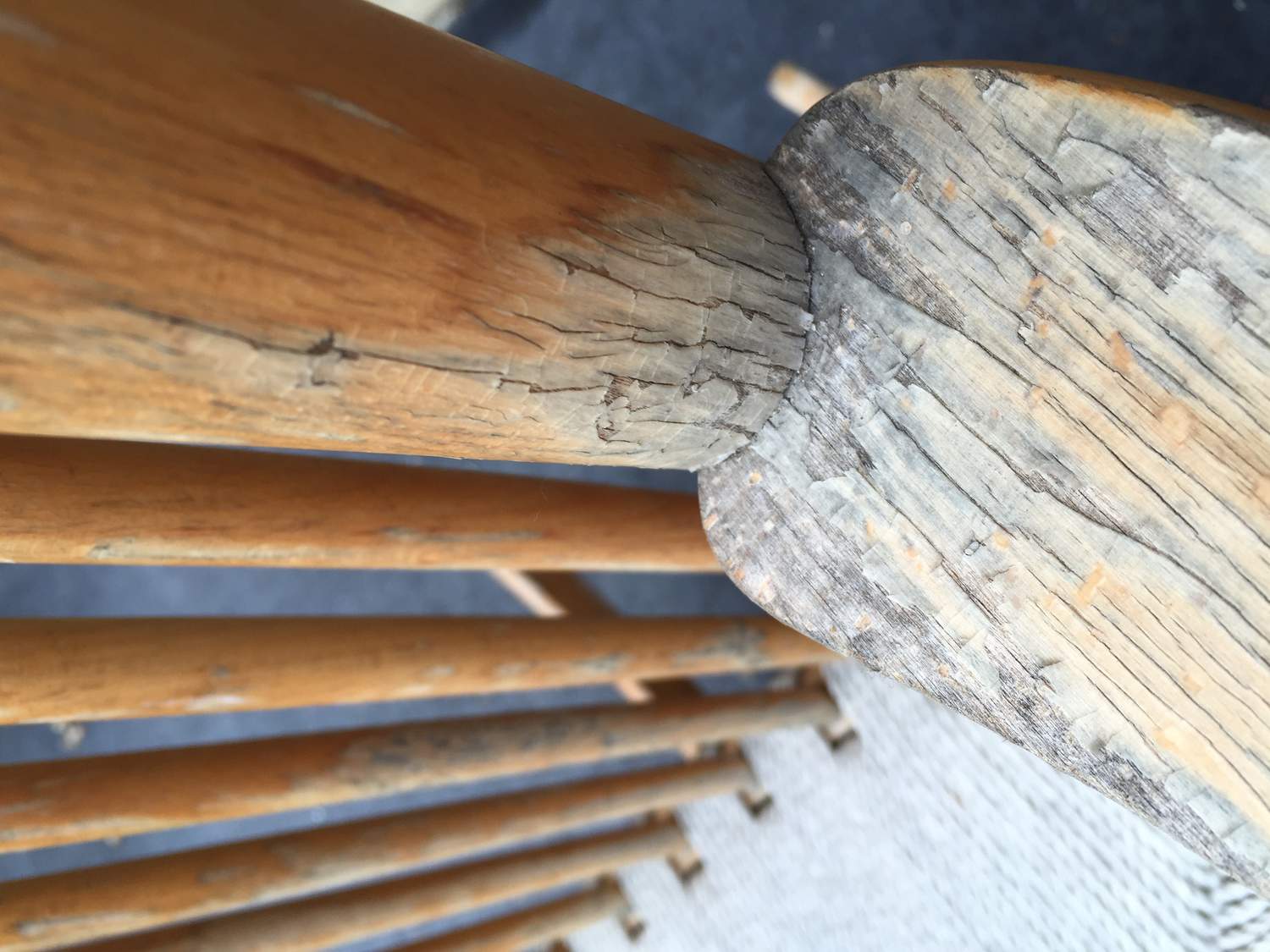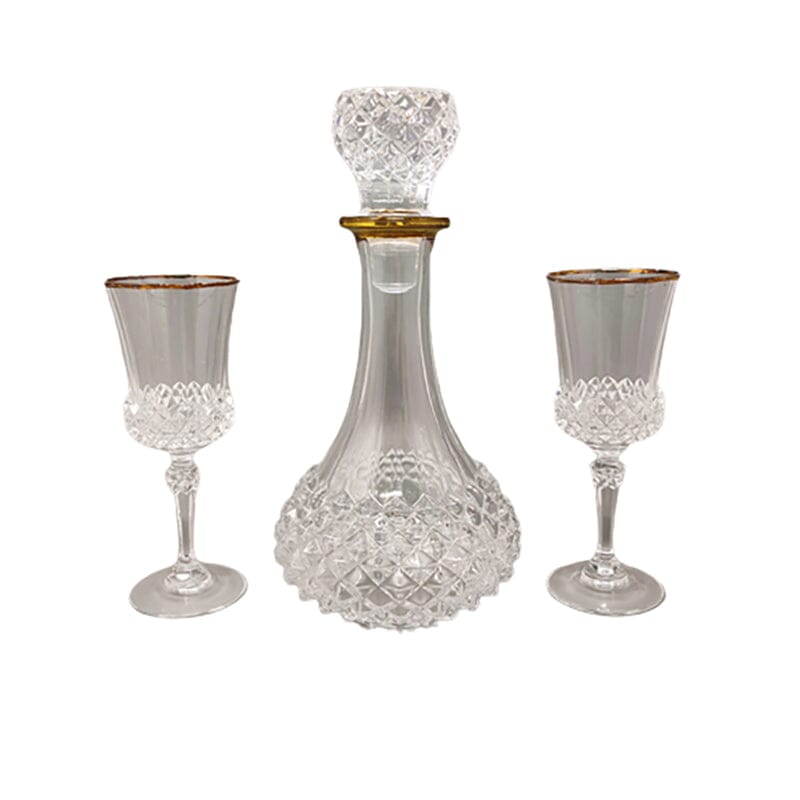I'm not starting on this project anytime soon, just beginning the pondering stage. I picked up this Wegner J16 rocker recently for cheap. It's beech with a lacquer finish, and I think it was used as a porch rocker because the lacquer on all front-facing parts is cracked and peeling but it's ok on the back. There are a few small splits in the wood here and there but all joints are still tight, amazingly enough.
I was thinking I'd strip the remaining lacquer and sand as needed to get down past the grayed, weathered wood---but how deep could that go? Am I looking at a billion hours of tedious, odious hand sanding? (I hate sanding.)
Would oxalic acid bleach the gray out? I'm guessing not. Originally I thought I'd do a soaped finish with some white pigment added for that really pale, raw wood color but obviously that won't work if the gray is very deep. I can see that even with heavy sanding, there may still be little veins of gray where those tiny splits are now. Never mind the few that are not so tiny. Black lacquer may be the solution. Or red---why not?
It's in storage right now, mostly to keep myself from doing some test sanding which I know will not be able to stop doing, and I have way more pressing work to do right now so I can't risk that.
Opinions? Facts? Anything?
 <img class="wpforo-default-image
<img class="wpforo-default-image
Definitely try the acid... why not? It's fixed similar things for me. If it doesn't work, you could still go for a pale finish, perhaps oil and soft wax, and use an opaque oil paint to cover the dark spots? That is a lot of damage, though. You could make a filler from glue and sanding dust to fill in some of those cracks. I'm sure somebody else here will have better advice!
I would not expect the graying to be very deep. It is kind of unfortunate that the joints are tight, because it wouldn't take long at all to sand that down--disassembled. I would actually consider knocking the joints apart unless any of them are cross pinned or otherwise done in some manner that is more difficult that steaming the glue and tapping with a mallet. If any joint shows the slightest looseness I would just disassemble it, too
The texture of the wood, on the surface, is going to be different where it has suffered that level of water damage, so you really need to sand of that surface layer of damaged wood. Oxalic will probably fix the color issue, but not the texture.
After sanding, if there are splits that are gray inside, oxalic will very likely clear that up. And if you can then get some glue into the split and clamp it closed (test clamp first, obviously), that would fix the split. Or a sawdust patch with school glue if it is a non structural aesthetic split.
If it is for some reason not possible to get the chair back to an appropriate natural beech appearance, this model originally came in black as well, so the chair could be patched up and ebonized. I suspect that the natural wood might be more desirable, but at least in black it would be true to one of the original finishes.
Thanks, guys. Kind of what I thought, I guess---that there's no way around sanding. I would really like to avoid knocking the joints apart and am hoping that they're all definitely tight when i can get to looking at them closely. A cursory check turned up nothing very obvious. Who knows, though. I am not good at re-gluing chairs other than really minor stuff so I'd like to avoid that if possible, which means sanding whole rather than in pieces. I will try to find the right blades to scrape the tight spots, maybe.
I looked online and found some red ones that looked like old finishes but of course they could have just been repainted long ago. (Found some other interesting and kind of awful colors, too--obviously not original! Mint green, for one. Agh.) I had my own lacquered in black because I just don't care for beech in general. It's the peachy undertone that I don't like, especially with paper cord--not enough contrast yet too different in color? Something. Anyway, I LOVE this chair in black. So if I have to do that route, that's fine---just not sure I have the skills to do it myself and I'm planning to sell it so I'd rather keep restoration expenses down. But that's another issue.
Friends of mine have two of these in their shop right now and the feedback they get is that the backs aren't comfortable (which I agree with, but all you need is a low back pillow), and that they look old-fashioned. I think that was my impression at first glance too, but only for about 30 seconds. Then I got it. The two in the shop are black and beech and I haven't heard about a preference for either. Other black lacquered and ebonized furniture goes pretty quickly so I think it may be the other two things. *I* don't quite get it but to each his own!
It's probably just me, spanky, but the finish on your chair looks to be very honest and cool. The seat appears tight and bright. I detest "chabby chic", but your chairs finish whispers words of love into my non-pierced ears. Well worn, but still rockin'. Just don't allow anyone to lick it. I like it. Yes. Rocking chairs are meant to expect high mileage.
Rock on, sugar,
Your Aunt Mark
Oh Aunt Mark, I thought you might be in favor of leaving it as is! I like certain kinds of things in a weathered state (Harrison Ford would be an example) but not this thing. For one, the arms are very rough to the touch which doesn't invite using the arm rests at all. And the weathering is actually kind of uneven and strange, like there's one sort of pitted area in the top back but lacquer remains around it. I've been wondering how that could have happened.
The cord seat is intact but it has that pale gray color of a cotton hammock that's been left out for a few seasons or more. I think what happens is that mildew starts to grow when it's damp, but then a hot, sunny, dry spell comes along and bleaches out the mildew almost completely but there's always a faint hint of it. Lather, rinse, repeat all summer long, and next summer, and the next, etc.
The underside of the seat has really gross-looking brown water stains that I think might be the pigment from the brown paper?? I hope that's all it is.
I too hate faked weathering and wear with a passion. Especially furniture where the paint is "worn off" in places where human bodies wouldn't have touched it much. That's so silly.
Hello spanky.
Hi.
Could you perhaps lightly refreshen the arms for comfort, leaving the rest of the lovely chair clad in its patin'd drag?
Hell, let's have a beverage.
Yes,
Hi,
Aunt Mark
edit time ...wabi sabi time ...reality check for me. I know that you will make that chair proud, spanky. I do. Yes. Yes.
There is rather a lot of artifice in wabi sabi. It is just very artfully done. I suppose this rocker could retain the wear it has accrued, while having the arms very artfully sanded and just the appropriate amount of wear in just the right placed returned to them. I imagine this might be a process that requires a lot of time, like cultivating a fantastic bonsai. This would be quite interesting. I would love to see photos of the process.
And I do not doubt that inventing the bonsai-like art of rocking chair maintenance would require a very significant investment of time, thought, and work. But most things worth doing are worth working at....
So, i started working on this.
I sanded it with 60 grit on a pad sander to get the remaining varnish off, but gave up on that when I got to the back where the varnish was mostly intact. I used methylene chloride stripper which seemed to lift the varnish off nicely within ten minutes or so, until I realized there was another coat under that that was unscathed! So i stripped it some more. Ugh.
Then I decided to try wood bleach in case it would lighten the grayed parts enough that i wouldn't have to do anymore heavy sanding.
I used Savogran crystal wood bleach in a slightly stronger concentration than they recommend---twice---and I got rid of the very lightest graying but there's still a lot left. I also scraped the wood in places and that got ride of some of the grayed material but not all by any means. I mean, not all in the tiny areas that i scraped. It seems to be pretty deep.
So here are a few before photos and some detail shots after two applications of bleach on subsequent days (totally rinsed and dried with a towel and 24-hour fan in between)---both wet and dry.
I like how it looks dry---except for the gray---and am seriously thinking about doing an soap finish with a little titanium white pigment added in hopes that it will cover the gray a bit. It's not nearly as noticeable when the chair is dry except for a few areas.
Of course the grain is horribly raised now and I will still have to sand it for hours and hours and hours and hours.
Opinions? Especially on whether a little pigment in the soap will help it cover? I could always do black enamel if soap won't work.


I would try a little spot of white tinted soap on the inside of one of those rockers. See what happens. The one time I've used soap, it was not tinted so I couldn't really say. The chairs I used it on did have a bit of water staining, and it did not seem to darken the water staining quite as much as an oil finish would, so I think it is not wholly unreasonable to think the idea might work. Also depends on how much white tint you use I suppose.
Thanks, that's what I wanted to hear! I suppose it if doesn't cover the gray enough I can always rinse the soap off with water, which is easy enough to do. And then do black lacquer, though that's not a process I am comfortable doing myself and if I pay someone to do it then I will not make any profit at all when I sell it---which I would if it was black because I already have a black one.
I'm also thinking that this is a chair brought back from the dead and it will be ok if a hint of its past is visible. Just not TOO visible.
I just finished sanding off the raised grain and am slightly encouraged, if only because I'm realizing it might not take me as long as I thought to do the whole chair up to about 400 grit or so.
If you need any help, please contact us at – info@designaddict.com









